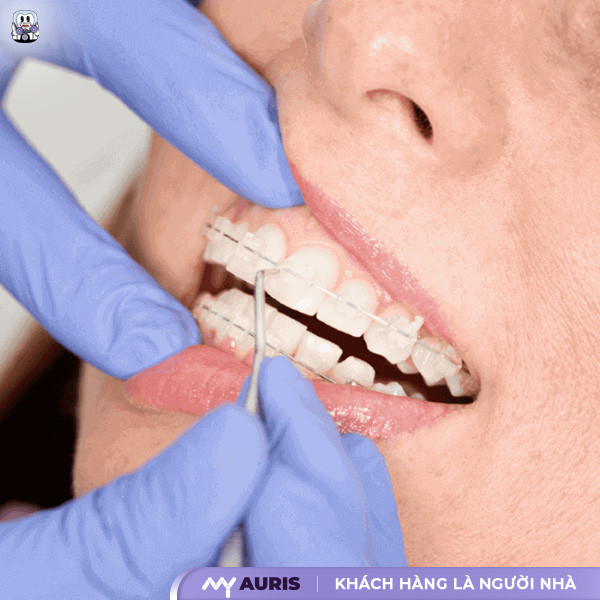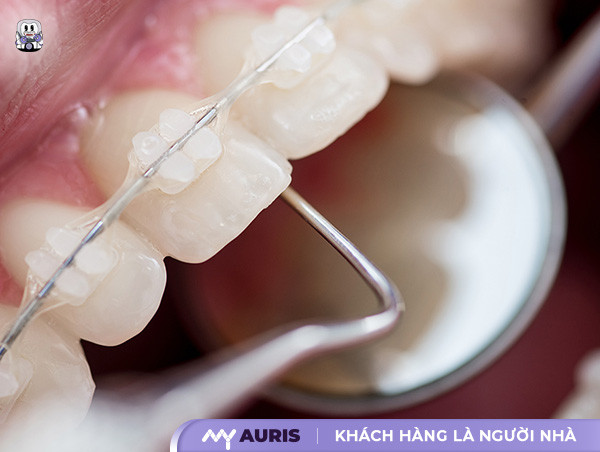Crystal orthodontic braces are becoming increasingly popular due to their high aesthetic appeal and noticeable orthodontic effectiveness. With a sophisticated, almost transparent design, this type of bracket helps users communicate confidently throughout the treatment process. So, are crystal braces good, and are they the optimal choice for you? The article below from My Auris will provide detailed information about the bracing process, who is suitable for this orthodontic method, and why more and more people trust and choose it.
What are Crystal Braces?
Crystal braces are a modern aesthetic orthodontic method that uses a clear crystal bracket system with transparent color, combined with white archwires, offering high aesthetic appeal. Crystal brackets are attached directly to the tooth surface, and the archwire is fitted into the bracket slot to create pulling force, helping to move teeth to their precise positions on the dental arch. The operating principle is similar to traditional braces, but thanks to titanium-slotted crystal or transparent Crystal, this method helps avoid the aesthetic drawbacks of metal braces.

Concepts of Crystal Braces and Glass Braces
Crystal braces and glass braces are often mistakenly thought to be the same, but there are clear differences in material and effectiveness. Medical-grade crystal is made from high-grade synthetic materials, which are more durable than ordinary glass and less prone to cracking or breaking under strong tightening forces.
Crystal braces use a system of solid crystal brackets with natural light reflection, providing an almost transparent appearance. In contrast, glass brackets are made from medical glass, are often thicker, and are more susceptible to scratching if not cleaned properly.
It is important to choose the right type of bracket that suits your tooth structure, bite, and desired treatment time. If you prioritize durability, safety, and high orthodontic effectiveness, crystal braces are a more worthwhile consideration than glass.
Structure of Crystal Braces and Differences from Metal Braces
The structure of crystal braces includes a transparent bracket body, an archwire slot, and hooks for orthodontic elastics. Medical-grade crystal material has moderate force resistance, sufficient to correct mild to moderate tooth misalignment conditions within 18–24 months.
Compared to metal braces, the first difference is aesthetics. Metal braces are often bright-colored, easily visible when speaking or smiling. In contrast, crystal braces are as transparent as natural teeth, suitable for those with high aesthetic demands. However, metal braces have better durability and force resistance, which helps shorten treatment time in severe misalignment cases.
Additionally, the level of pain or discomfort when first getting crystal braces is often lower due to their smooth and lighter surface compared to metal. The practical advice is that if you aim for a balance between aesthetics and effectiveness, and do not have severe bite misalignment, crystal braces would be a suitable choice.
Are Crystal Braces the Same as Clear Aligners?
Many people confuse crystal braces with clear aligners like Invisalign, but these are two entirely different methods. Crystal braces use transparent brackets fixed to the teeth, while Invisalign uses removable clear aligners. Crystal braces are a fixed bracket system that uses archwires and elastics to create tightening forces to adjust teeth. Wearers must visit the dentist for regular check-ups and adjustments. In contrast, Invisalign aligners are designed for each stage, and users can change aligners themselves at home according to a predefined schedule, requiring less direct intervention from the dentist.
The advantage of crystal braces is their clear, stable effectiveness and tighter control over the tightening force. Invisalign is suitable for busy individuals who are highly disciplined in wearing aligners for 22 hours a day. Regarding cost, crystal braces are generally cheaper than Invisalign but more expensive than metal braces.

Distinguishing Between Crystal Braces and Ceramic Braces
Among aesthetic orthodontic methods, both crystal braces and ceramic braces are highly regarded for their aesthetic appeal, making them suitable for many people’s beauty needs. Although they have a similar design and both work based on the principle of creating traction to move teeth to their precise positions on the dental arch, there are still some notable differences between them.
Similarities Between Crystal and Ceramic Braces
Equivalent Orthodontic Application: Both types of bracket systems are indicated for cases of misaligned teeth, overbites, underbites, protrusion, or malocclusion. They help reshape the dental arch, delivering a beautiful, even smile as desired.
Similar Structure and Operating Principle: Both crystal and ceramic brackets are attached directly to the tooth surface, combined with white or clear archwires, which are fitted into the bracket slot, thereby generating stable pulling force to move teeth effectively.
Equivalent Treatment Duration: Whether clear crystal or ceramic brackets are used, the wearing time typically ranges from 1 to 3 years, depending on each individual’s tooth condition. Afterward, users will have straight, beautiful, natural-looking teeth.
Easier Oral Hygiene: Compared to metal braces, these two types of brackets reduce plaque accumulation and are easier to clean, thereby lowering the risk of oral diseases.
Differences Between Crystal and Ceramic Braces
Regarding Aesthetics:
Transparent Crystal possesses a clear color that blends with tooth color, making it very difficult to detect during communication, thus avoiding the aesthetic disadvantages often seen with traditional methods.
Ceramic braces also have a color similar to tooth enamel but are not as transparent as titanium-slotted crystal, thus having slightly lower aesthetic appeal.
Regarding Durability:
Although beautiful, crystal braces are more brittle and prone to cracking or breaking under strong force.
Conversely, ceramic braces have higher durability and better impact resistance, making them safer for long-term use.
Regarding Orthodontic Effectiveness:
Due to the lower hardness of crystal, the pulling force of the archwire through crystal braces is weaker, which may reduce orthodontic effectiveness compared to ceramic braces.
In contrast, ceramic braces transmit force steadily and consistently, making the orthodontic process with brackets more effective and continuous.
Regarding Wearing Comfort:
Crystal braces often have a larger design, occupying more space on the teeth, which can cause bulkiness or discomfort.
Meanwhile, modern ceramic brackets are designed to be compact with soft, rounded corners, providing a more comfortable feeling, suitable even for those new to braces.
Advantages and Disadvantages of Crystal Braces
Crystal braces are a popular aesthetic orthodontic method, suitable for adults and those who need to communicate frequently. However, this method also has advantages and disadvantages that need to be considered.
Advantages
Crystal brackets are made from transparent medical-grade material, which enhances aesthetics and confidence in communication. They still use archwires to effectively move teeth, ensuring stable treatment results and a duration comparable to metal braces. The feeling of wearing them is quite comfortable, without feeling heavy on the face. This type of bracket has high adhesion, allowing for good control of the tightening force. Crystal braces are suitable for a diverse range of people, especially those with high aesthetic demands.
Disadvantages
Crystal brackets are not as durable as metal, easily breaking if subjected to strong impacts or chewing hard food, which can prolong treatment time. The cost is often higher than metal or ceramic braces. Due to their transparency, the brackets are prone to staining if oral hygiene is not strictly maintained, reducing aesthetic appeal. The technique of attaching crystal brackets requires high skill from the dentist; otherwise, it can easily lead to loose brackets or tooth pain. Finally, this method is not suitable for complex tooth misalignment cases that require strong traction.
Who Should Get Crystal Braces?
Adults with high aesthetic needs: If you are working, frequently communicate, or work in an environment that requires a professional image, crystal braces are a reasonable choice. Crystal braces are transparent and difficult to notice when viewed directly, making them suitable for those who don’t want others to realize they are undergoing orthodontic treatment.
People with mild to moderate tooth misalignment: The crystal brace system is best suited for mild to moderate orthodontic cases. Conditions such as slightly crooked teeth, mild overbites, midline deviations, or small open bites can be effectively treated with this aesthetic orthodontic technique.
People who do not participate in contact sports or strenuous activities: Due to the brittle nature of medical-grade crystal material, crystal brackets are prone to cracking or breaking when subjected to strong impacts. Those who regularly play contact sports like football, martial arts, or need to wear mouthguards should be cautious when choosing this type of bracket.
People with good oral hygiene discipline: The process of orthodontic treatment with any type of bracket requires thorough cleaning, but with crystal braces, this is even more crucial. While this type of bracket has relatively good stain resistance, it is not entirely immune to staining.
People with a moderate budget but still requiring aesthetics: Crystal braces have an average price higher than metal braces but lower than Invisalign.

Crystal Brace Treatment Process at the Dental Clinic
Crystal braces are an aesthetic choice favored by many adults. This scientific orthodontic process typically lasts 1.5 – 2 years and includes multiple stages, supervised by a specialist dentist.
Consultation and 3D Dental X-ray
In the first session, the dentist will conduct a general examination of the teeth, bite, and dental arch. X-rays or 3D CT scans help accurately analyze the structure of the teeth, jawbone, tooth roots, and impacted teeth. The 3D imaging results form the basis for designing brackets, selecting archwires, and predicting the duration and complexity of the bracing case. You also need to provide your medical history and relevant information.
Personalized Treatment Plan Design
Based on the imaging data, the dentist will create a detailed treatment plan, including the order of tooth movement, estimated duration, choice of bracket type, archwire, and auxiliary appliances. This plan is personalized because each person’s jawbone structure is different, and it may include tooth extraction or the use of mini-implants for complex cases. A clear plan helps you understand the entire process, duration, and cost.
Crystal Brace Placement and Regular Follow-ups
The dentist will clean your teeth and attach the crystal brackets to each tooth using medical adhesive, then place the archwire and adjust the tightening force. You will need to return for regular check-ups every 3–5 weeks to adjust the pulling force, change elastics, and monitor progress. The dentist will address any issues that arise, such as detached or broken brackets. You need to avoid hard, sticky, and stain-causing foods to protect the brackets.
Average Duration of Wearing Crystal Braces?
The average treatment time with crystal braces ranges from 18 to 24 months, depending on the initial degree of tooth misalignment and age. Mild cases may be completed sooner (15–18 months), while severe overbite or underbite cases require a longer time. The effectiveness and duration of orthodontics depend on the dentist’s technique, your compliance with follow-up appointments and care, as well as each individual’s response rate.

How Much Do Crystal Braces Cost?
Currently, the cost of crystal braces ranges from 30 – 60 million Vietnamese Dong (VND), depending on various factors that determine the price. Among these, the brand of crystal you choose is a key factor affecting the price. Additionally, the bracing method (conventional or self-ligating brackets) and your oral condition also contribute to changes in the fee.
2025 all-inclusive price list for crystal braces:
| Type of Braces | All-inclusive Price (VNĐ/case) |
| Crystal Braces (Crystal stone) | 35,000,000 – 45,000,000 VND/case |
| Self-Ligating Crystal Braces | 40,000,000 – 55,000,000 VND/case |
| Jade Braces | 40,000,000 – 50,000,000 VND/case |
| Sapphire Braces | 45,000,000 – 55,000,000 VND/case |
Factors Affecting the Price of Crystal Braces
- Initial Oral Condition: If teeth are severely crooked, crowded, or there are significant bite issues, treatment time will be longer → higher cost.
- Orthodontist’s Expertise: Highly specialized and experienced dentists often come with a higher cost but ensure long-term and stable results.
- Bracket System and Material: Crystal braces have stain-resistant properties, reflect light, and are less prone to discoloration than ceramic braces.
- Treatment Technology: Clinics using modern orthodontic technology such as 3D scanning and result simulation will have a slightly higher cost but increase effectiveness.
Notes on Dental Care During Crystal Bracing
This is a crucial stage that determines the treatment outcome, bracing duration, and even facial aesthetics. However, in reality, most people undergoing braces are not properly instructed on how to care for their teeth throughout the time they wear brackets:
- Eat Properly to Protect Crystal Braces
Avoid eating foods that are too hard, sticky, or chewy. Items like spare ribs, gummy candies, grilled rice paper, or ice cubes can cause the crystal brace system to crack or detach from the teeth. When a bracket cracks, orthodontic effectiveness will decrease, and treatment time will increase.
You should cut food into small pieces and chew with your back teeth to reduce direct force on the orthodontic archwire and clear brackets. Limit biting directly with your front teeth – the position where brackets are most likely to detach. You’ll quickly adapt by changing your eating habits within the first 1–2 weeks.
- Thorough Daily Oral Hygiene
Brush your teeth after every meal with a soft-bristled toothbrush and low-foaming toothpaste. Use an interdental brush or a water flosser to clean around the crystal brace system.
Some reputable dental clinics also instruct patients with braces on how to clean the area around the elastic archwire and orthodontic elastics, ensuring no food residue – a factor that causes bad breath and increases the risk of inflammation.
- Adhere to Appointments and Early Detection of Abnormalities
Follow-up appointments are not just for tightening the braces but also an opportunity for the dentist to check orthodontic effectiveness, bracket adhesion, and the teeth-jaw’s response to the pulling force. Do not delay appointments for more than 2 weeks unless instructed by a specialist orthodontist.
Additionally, you need to monitor for signs such as:
- Brackets becoming detached or misplaced
- Archwire bending or causing prolonged pain
- Gum inflammation or swelling around the tooth root
If you notice any signs, contact your treating dental clinic immediately. Avoid self-adjusting or removing orthodontic appliances at home, as this can disrupt the treatment plan.
- Protect Teeth and Braces During Activity or Sleep
When playing sports, wear a mouthguard to prevent impacts that could break crystal braces. Although aesthetic, this type of clear bracket is more prone to cracking than metal braces. Also, if you grind your teeth in your sleep, inform your dentist so they can design a suitable night guard.
- Maintain Stable Mental Health and Regular Lifestyle
Orthodontics is not just a dental treatment but also affects daily life and mental well-being. You should get enough sleep, avoid stress, and eat a nutritious diet to keep your teeth strong and healthy. This contributes to enhancing orthodontic effectiveness and shortening the time you wear braces.





